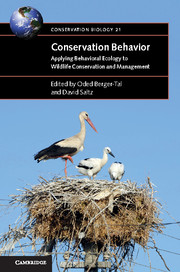Book contents
- Frontmatter
- Dedication
- Contents
- List of contributors
- Prologue
- Preface
- Acknowledgments
- Part I The integration of two disciplines: conservation and behavioral ecology
- Part II Anthropogenic impacts on animal behavior and their implications for conservation and management
- Part III Behavior-based management: using behavioral knowledge to improve conservation and management efforts
- Part IV Behavioral indicators
- Index
Prologue
Published online by Cambridge University Press: 05 April 2016
- Frontmatter
- Dedication
- Contents
- List of contributors
- Prologue
- Preface
- Acknowledgments
- Part I The integration of two disciplines: conservation and behavioral ecology
- Part II Anthropogenic impacts on animal behavior and their implications for conservation and management
- Part III Behavior-based management: using behavioral knowledge to improve conservation and management efforts
- Part IV Behavioral indicators
- Index
Summary
Like A. A. Milne's Winnie-the-Pooh, real bears love rich food, and just like Pooh, real bears strive to minimize the costs and maximize the benefits of obtaining that food. Like Pooh, real bears also don't realize the possible consequences. In Pooh's case, his attempts to get free food result in him becoming stuck in one of the entrances to Rabbit's den, after consuming all of Rabbit's honey, and becoming too fat to go back out the way he came in. In the real world, bears learn very quickly that humans can provide easy access to food resources that will increase their net energetic return, and start seeking out human activity and steal or beg for food.
“Don't feed the bears!” is a line commonly appearing on roadside notices in many US National Parks. It encompasses the realization that our actions may alter the behavior of the species around us; a realization that took many years to materialize.
Initially, the begging behavior of bears was considered amusing and the US Park Service actually encouraged this, so called, habituation. It was not long before problems concerning human safety began surfacing. Bears began actively seeking human contact and occasionally would become aggressive towards visitors who would not “share their lunch”. In 1902, the Park Service outlawed the hand feeding of bears, but did not enforce it and the practice continued. The situation became increasingly dangerous for both humans and bears. Fatal attacks on humans became common and problem bears were shot. Finally, in 1970, the Park Service began enforcing the law and devised various methods to prevent bear access to anthropogenic food sources. These include raising awareness in humans, preventing the bears from accessing food (e.g. introducing bear-proof containers), and using bear deterrents and aversive behavioral conditioning to keep bears away. Behavioral conditioning relies on our understanding of how bears learn and how they react to novel stimuli, and behavioral ecologists continue to devise better and more effective methods that will allow wildlife managers to resolve human-bear conflicts in an efficient, non-lethal manner.
Avoiding the consequences that may follow human-wildlife contacts is but one example of how looking at the world from the animal's point of view can improve the way we conserve and manage wildlife. “Thinking like a mountain” is what conservation behavior is all about.
- Type
- Chapter
- Information
- Conservation BehaviorApplying Behavioral Ecology to Wildlife Conservation and Management, pp. xiii - xivPublisher: Cambridge University PressPrint publication year: 2016

